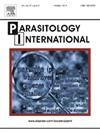Genetic diversity and phylogeography of the global Theileria orientalis isolates inferred from MPSP gene sequences
IF 1.5
4区 医学
Q3 PARASITOLOGY
引用次数: 0
Abstract
Background/objective
Theileria orientalis is a non-transforming Theileria species infecting cattle and water buffaloes. Several outbreaks of oriental theileriosis accompanied by considerable economic loss were documented in Asia, Australia, and New Zealand. The major piroplasm surface protein (MPSP) gene has frequently been used to molecularly characterize T. orientalis isolates worldwide. Various MPSP genotypes were detected with significant virulence variations. The present study provides the first in silico analysis for all globally published T. orientalis MPSP isolates to evaluate their phylogeny, diversity, and population structure.
Methods
All studies that tested T. orientalis isolates using PCR-MPSP protocols were systematically collected from various databases. Theileria orientalis MPSP-sequenced isolates on the GenBank were collected and the sequences were tested for their phylogenetic relatedness, genetic diversity, recombination, natural selection, and population structure using various software.
Results
The collected T. orientalis-MPSP isolates (n = 795) were clustered into 12 genotypes, including types 1 (Chitose), 2 (Ikeda), 3 (Buffeli), 4, 5, 7, 8, and N1-N5. The previously identified type 6 belonged to a separate species (Theileria sinensis). The previously identified type 9 was transferred to type 4. Two unidentified isolates from water buffaloes in India were clustered into a new suggested genotype “type N5”. Of the 12 genotypes, Ikeda (type 2) is the most virulent in cattle. However, a few clinical cases have also been linked to types 1 (Chitose) and 7. In water buffaloes, T. orientalis outbreaks have been linked to genotypes N2 and N5. Geographic mapping of various genotypes revealed the dispersal of types 1 and 3 worldwide. Overall, the 795 isolates comprised 532 haplotypes and displayed very high nucleotide (π = 0.14) and haplotype (Hd = 0.995) diversities. As a result, a very low sequence conservation value (C = 0.207) was determined. The twelve genotypes displayed comparable haplotype diversities accompanied by statistically significant negative Tajima's D and Fu's Fs values suggesting population expansion. A high value for the minimum number of recombination events (Rm = 65) was estimated for the 795 isolates, and this value varied from 0 to 23 at the genotype level. Most types also displayed significant positive selection (dn/ds ratio > 1). This suggests that both recombination and positive selection occur in T. orientalis MPSP gene, which could explain the very high genetic diversity among various T. orientalis types. Different patterns were detected for the gene flow among T. orientalis populations from various hosts and geographies; however, there is evidence for the genetic relatedness between populations from neighbouring countries.
Conclusion
The high genetic polymorphism and different associated pathogenicity in T. orientalis-MPSP genotypes highlight the need for further investigations employing whole genome sequencing technology to provide accurate comparative gene-level analyses and help further understand their pathogenicity.

从MPSP基因序列推断的全球东方蓟马分离株的遗传多样性和系统地理。
背景/目的:东方伊勒菌是一种感染牛和水牛的非转化性伊勒菌。据记载,在亚洲、澳大利亚和新西兰暴发了几次东方血吸虫病,并造成了相当大的经济损失。主要的梨质表面蛋白(MPSP)基因在世界范围内经常被用来对东方弓形虫的分离物进行分子表征。检测到不同MPSP基因型具有显著的毒力差异。本研究首次对全球已发表的东方蓟MPSP分离株进行了计算机分析,以评估其系统发育、多样性和种群结构。方法:系统收集各数据库中所有采用PCR-MPSP协议检测东方弓纹虫分离物的研究。收集GenBank上经mpsp测序的东方菌分离株,利用不同软件进行系统亲缘性、遗传多样性、重组、自然选择和群体结构分析。结果:收集到的东方绦虫- mpsp分离株(n = 795)可聚为12个基因型,包括1型(Chitose)、2型(Ikeda)、3型(Buffeli)、4、5、7、8和n1 ~ n5。先前鉴定的6型属于一个单独的种(Theileria sinensis)。先前确定的9型被转移到4型。从印度分离的两株未确定的水牛聚类为一种新的建议基因型“N5型”。在12个基因型中,池田(2型)对牛的毒性最大。然而,少数临床病例也与1型(千年虫)和7型有关。在水牛中,东方弓形虫暴发与基因型N2和N5有关。不同基因型的地理图谱揭示了1型和3型在世界范围内的分布。总体而言,795株分离物包含532个单倍型,核苷酸(π = 0.14)和单倍型(Hd = 0.995)具有很高的多样性。因此,确定的序列保守值很低(C = 0.207)。12个基因型具有相当的单倍型多样性,Tajima's D和Fu's Fs值均为负,具有统计学意义,表明种群扩张。估计795株菌株的最小重组事件数的值较高(Rm = 65),该值在基因型水平上从0到23不等。大多数类型也表现出显著的正选择(dn/ds比 > 1)。这说明东方桦MPSP基因存在重组和正选择的双重作用,这可以解释东方桦不同类型间具有很高的遗传多样性。不同寄主、不同地域的东方田鼠种群间基因流动模式存在差异;然而,有证据表明来自邻国的人群之间存在遗传相关性。结论:东方弓形虫- mpsp基因型具有较高的遗传多态性和不同的相关致病性,需要进一步利用全基因组测序技术进行研究,以提供准确的比较基因水平分析,进一步了解其致病性。
本文章由计算机程序翻译,如有差异,请以英文原文为准。
求助全文
约1分钟内获得全文
求助全文
来源期刊

Parasitology International
医学-寄生虫学
CiteScore
4.00
自引率
10.50%
发文量
140
审稿时长
61 days
期刊介绍:
Parasitology International provides a medium for rapid, carefully reviewed publications in the field of human and animal parasitology. Original papers, rapid communications, and original case reports from all geographical areas and covering all parasitological disciplines, including structure, immunology, cell biology, biochemistry, molecular biology, and systematics, may be submitted. Reviews on recent developments are invited regularly, but suggestions in this respect are welcome. Letters to the Editor commenting on any aspect of the Journal are also welcome.
 求助内容:
求助内容: 应助结果提醒方式:
应助结果提醒方式:


